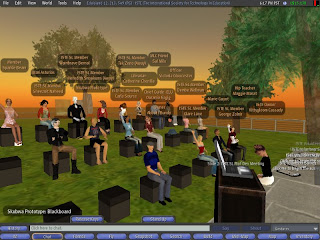Typical teen stuff, what to wear to the prom, choosing a college and so forth. However, one article caught my eye "MySpace, IM--why so addictive?"
We spend a lot of time in the blogosphere talking about the future of learning, making predictions and lamenting formal instructional design but rarely is the voice of the "gamer generation" heard...the voice of the learners who will be demanding that we design instruction differently.
This article, written by Ms Abbey Stahl from Shikellamy High School, provides insight into the thinking of current high school students. The article provides great information about what the upcoming gamer generation is going to demand in terms of learning.
Here is some of the article:
Yes, these terms --Instant Messanger and Myspace--may seem foreign to your parents, but to us teenagers they're essential to keep up with the lastest ins and outs. Communication has developed enormously in the last couple hundred years. It used to be that people would have to travel miles to talk to a person before the postal service was established. But who wants to mail a letter and wait a week for the reply? Now telephones are even becoming impractical. Is the internet the new communication wave of the future? Nearly any Myspace or Instant Messenger user will tell you that they are addicted to it. Why?
It's a fact that us teenagers, more than anyone need to talk to our friends. We can easily carry [on] more than one converation, listen to music and search the web for a homework assignment all at once.
First I was really struck by the comment, "Now telephones are even becoming impractical." Not obsolete but impractical. Not practical to use...a telephone. So the gamers find it more practical to communicate via the Internet than via a telephone.
Also, the social aspect of the Internet is an important and a integral part of being a teenager and communicating with others. Social networking is, as stated often, critically important to this gamer generation. We need to be prepared to leverage this fondness for electronic social networking.
Finally, Ms Stahl (probably 16 or 17) tells us adults what we have frustrately witnessed for years--teenagers expect to multitask and enjoy dealing with the whirlwind of technology that is constantly at their finger tips. Rather than be overwhelmed by it, they embrace it.
Thank you to Ms Stahl for re-confirming the fact that the gamer generation is coming and that they have different learning and information expectations than the boomers or the Gen Xers. Anyone responsible for providing learning opportunities for these gamers better be ready.
Thanks Abbey and a shout out to you.
__
Recommended Games and Gadgets
Recommended Books
Content Guide






















